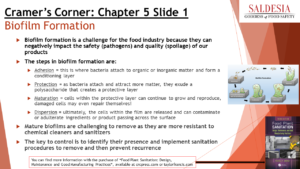Biofilm Formation


Bacteria can attach themselves to surfaces that aren’t adequately cleaned or that have rough texture, and then accumulate on that surface. They form a polysaccharide layer that protects them from chemical cleaners and sanitizers, thus creating a biofilm. This biofilm may contain generic organisms, spoilage organisms or even pathogens that mature over time. At some point, the protective layer dissolves allowing release of the organisms which can contaminate or adulterate the product. Details of biofilm formation are presented here in Cramer’s Corner, Chapter 5 Slide 1, and in greater detail in Chapter 5 of the book Food Plant Sanitation, entitled “Biofilms”.”
Slide Content
Biofilm formation is a challenge for the food industry because they can negatively impact the safety (pathogens) and quality (spoilage) of our products
The steps in biofilm formation are:
– Adhesion = this is where bacteria attach to organic or inorganic matter and form a conditioning layer
– Protection = as bacteria attach and attract more matter, they exude a polysaccharide that creates a protective layer
– Maturation = cells within the protective layer can continue to grow and reproduce, damaged cells may even repair themselves!
– Dispersion = ultimately, the cells within the film are released and can contaminate or adulterate ingredients or product passing across the surface
Mature biofilms are challenging to remove as they are more resistant to chemical cleaners and sanitizers
The key to control is to identify their presence and implement sanitation procedures to remove and then prevent recurrence
